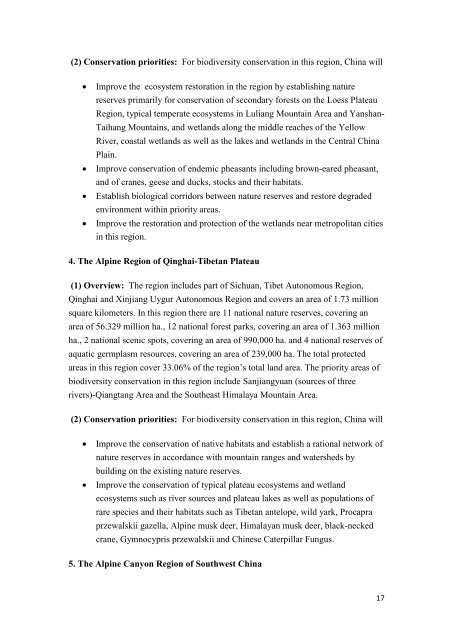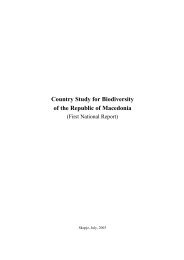English version - Convention on Biological Diversity
English version - Convention on Biological Diversity
English version - Convention on Biological Diversity
You also want an ePaper? Increase the reach of your titles
YUMPU automatically turns print PDFs into web optimized ePapers that Google loves.
(2) C<strong>on</strong>servati<strong>on</strong> priorities: For biodiversity c<strong>on</strong>servati<strong>on</strong> in this regi<strong>on</strong>, China will<br />
<br />
<br />
<br />
<br />
Improve the ecosystem restorati<strong>on</strong> in the regi<strong>on</strong> by establishing nature<br />
reserves primarily for c<strong>on</strong>servati<strong>on</strong> of sec<strong>on</strong>dary forests <strong>on</strong> the Loess Plateau<br />
Regi<strong>on</strong>, typical temperate ecosystems in Luliang Mountain Area and Yanshan-<br />
Taihang Mountains, and wetlands al<strong>on</strong>g the middle reaches of the Yellow<br />
River, coastal wetlands as well as the lakes and wetlands in the Central China<br />
Plain.<br />
Improve c<strong>on</strong>servati<strong>on</strong> of endemic pheasants including brown-eared pheasant,<br />
and of cranes, geese and ducks, stocks and their habitats.<br />
Establish biological corridors between nature reserves and restore degraded<br />
envir<strong>on</strong>ment within priority areas.<br />
Improve the restorati<strong>on</strong> and protecti<strong>on</strong> of the wetlands near metropolitan cities<br />
in this regi<strong>on</strong>.<br />
4. The Alpine Regi<strong>on</strong> of Qinghai-Tibetan Plateau<br />
(1) Overview: The regi<strong>on</strong> includes part of Sichuan, Tibet Aut<strong>on</strong>omous Regi<strong>on</strong>,<br />
Qinghai and Xinjiang Uygur Aut<strong>on</strong>omous Regi<strong>on</strong> and covers an area of 1.73 milli<strong>on</strong><br />
square kilometers. In this regi<strong>on</strong> there are 11 nati<strong>on</strong>al nature reserves, covering an<br />
area of 56.329 milli<strong>on</strong> ha., 12 nati<strong>on</strong>al forest parks, covering an area of 1.363 milli<strong>on</strong><br />
ha., 2 nati<strong>on</strong>al scenic spots, covering an area of 990,000 ha. and 4 nati<strong>on</strong>al reserves of<br />
aquatic germplasm resources, covering an area of 239,000 ha. The total protected<br />
areas in this regi<strong>on</strong> cover 33.06% of the regi<strong>on</strong>’s total land area. The priority areas of<br />
biodiversity c<strong>on</strong>servati<strong>on</strong> in this regi<strong>on</strong> include Sanjiangyuan (sources of three<br />
rivers)-Qiangtang Area and the Southeast Himalaya Mountain Area.<br />
(2) C<strong>on</strong>servati<strong>on</strong> priorities: For biodiversity c<strong>on</strong>servati<strong>on</strong> in this regi<strong>on</strong>, China will<br />
<br />
<br />
Improve the c<strong>on</strong>servati<strong>on</strong> of native habitats and establish a rati<strong>on</strong>al network of<br />
nature reserves in accordance with mountain ranges and watersheds by<br />
building <strong>on</strong> the existing nature reserves.<br />
Improve the c<strong>on</strong>servati<strong>on</strong> of typical plateau ecosystems and wetland<br />
ecosystems such as river sources and plateau lakes as well as populati<strong>on</strong>s of<br />
rare species and their habitats such as Tibetan antelope, wild yark, Procapra<br />
przewalskii gazella, Alpine musk deer, Himalayan musk deer, black-necked<br />
crane, Gymnocypris przewalskii and Chinese Caterpillar Fungus.<br />
5. The Alpine Cany<strong>on</strong> Regi<strong>on</strong> of Southwest China<br />
17
















